
 To begin putting the pieces of the puzzle together, read this biographical information about the Douglas family. Then, look at the inventory list of documents and click on each one to preview the old photographs and letters.
To begin putting the pieces of the puzzle together, read this biographical information about the Douglas family. Then, look at the inventory list of documents and click on each one to preview the old photographs and letters.
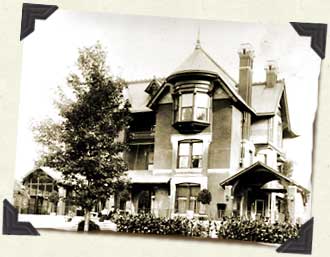 Brucemore c. 1909 To learn more about George B. Douglas, take a virtual field trip and visit to Brucemore, home of George and Irene Douglas and their three daughters, located in Cedar Rapids, Iowa.
Brucemore c. 1909 To learn more about George B. Douglas, take a virtual field trip and visit to Brucemore, home of George and Irene Douglas and their three daughters, located in Cedar Rapids, Iowa.


Bial, Raymond. Corn Belt Harvest. Houghton Mifflin, 1991.
Text and photos illustrate the cycle of corn production from field to factory.
Cooper, Jason. Corn: Farm to Market. Rourke, 1997.
Examines the importance of corn and explains how it is grown, processed, and shipped to the grocery store.
Hakim, Joy. An Age of Extremes. (History of the United States series, Book 8). Oxford University Press, 1999.
Covers important events in U.S. history from the 1880s to World War I.
Landau, Elaine. Corn (True Books-Food & Nutrition). Children's Press, 2000.
Describes the history, cultivation, and uses of corn.
Leuzzi, Linda. Transportation. Chelsea House, 1995.
Describes the early years of various forms of transportation, showing how people traveled during the last half of the 19th century and into the early 20th century.
History of Corn Refining
Provides a brief history of corn refining from its beginnings in 1844 to the present day.
The Corn Refining Process
The Corn Refiners Association presents a step-by-step description of the procedures in processing corn.
Corn Refiner's Association - Products - Starch
Describes the current uses of corn starches.
New Uses
The Iowa Corn Grower's Association describes new uses of corn in manufactured products.
What Can You Get From a Bushel of Corn?
The Ohio Corn Marketing Program presents a brief listing of what can be extracted from a single bushel of corn.
A Zillion Uses for Corn!
The Ontario Corn Producers' Association presents a comprehensive list of common products which are derived from corn.
Products that Use Corn
The Ontario Corn Producers' Association presents a comprehensive list of common products which are derived from corn.
Controlling Grain Dust Fires and Explosions
Describes the four ingredients necessary for a grain dust fire to occur.
Grain Dust Peril
Describes the history of grain dust explosions in the United States and discusses measures which can be taken to prevent explosions.
EyeWitness to the Twentieth Century
Presents key events of the twentieth century listed by year of occurrence.

1817 - George B. Douglas's father was also named George. George's father, George Douglas Sr., was a native of Scotland, born April 17, 1817.
1848 - He came to Rochester, New York in 1848 and entered the construction business, concentrating on railroads, bridges and canals.
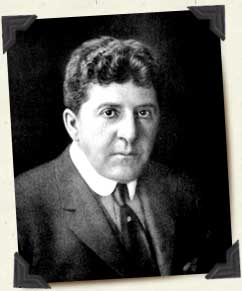 1850-70 - George Douglas Sr. followed the westward expansion of the railroads. In the early 1870's his company contracted with John I. Blair, railroad financier, to grade, lay track & construct bridges in western Iowa, eastern Nebraska and Texas.
1850-70 - George Douglas Sr. followed the westward expansion of the railroads. In the early 1870's his company contracted with John I. Blair, railroad financier, to grade, lay track & construct bridges in western Iowa, eastern Nebraska and Texas.
1874 - George Douglas Sr. entered a partnership with Robert Stuart in the manufacture of oatmeal and other cereal products. This partnership lasted until George Douglas Sr.'s death in 1884.
Portrait-- Young George B. Douglas
Courtesy of Brucemore National Historic Site
George Douglas Sr. had three sons- George B., William W. and Walter D.
The family business, known as North Star Oatmeal Mills,continued to grow as George Sr.'s three sons took active roles in its operation.
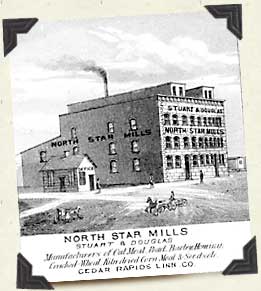
Engraving--North Star Mills, 1875
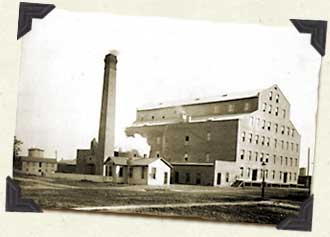
North Star Mills, 1887
Other Douglas family businesses were a shoe factory, Gates, Gifford and Douglas headed by Walter, and a cracker factory called Jones and Douglas, managed by George Sr.'s nephew James Douglas.
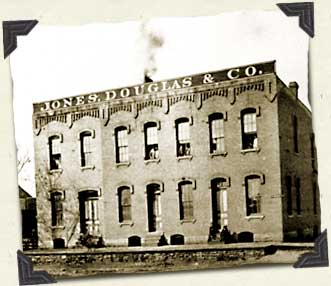
Jones, Douglas & Co. (cracker factory) 1887
1894 - The three Douglas brothers formed Douglas & Company to manufacture linseed oil. This company operated it at 6th St. & D Ave. in Cedar Rapids, Iowa.
1899 - The Douglas & Company was sold to the American Linseed Company.
1902 - George and Walter started building an independent starch manufacturing company. The company prospered and more than tripled its production in three years.
Important by-products of the starch making process were gluten feed used to fatten cattle, and corn oil which was used to manufacture soap in that era, rather than its present day use as cooking oil and in other food products.
1905 -Walter moved to Minneapolis where he developed interests in banking and grain processing.
1906 -George Bruce Douglas and his wife Irene Hazeltine Douglas moved to a mansion named Brucemore. The estate was renamed Brucemore because his middle name was Bruce. The Douglas family hired a Chicago architect Howard van to make $30,000 worth of renovations on the home.
The architect relocated the entrance to the south facade and built a terrace on the north side facing the huge lawn.
A sleeping porch was designed and created by Grant Wood, a local artist who later became world renowned for his Regionalist paintings, most notably American Gothic.
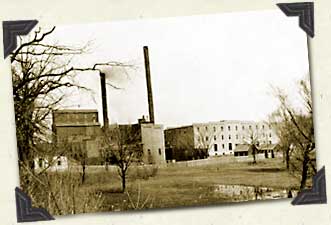
Douglas Starchworks 1906
1912 -Misfortune seemed to plague the Douglas family. Walter and his wife Mahala were touring Europe and were passengers on the voyage of the Titanic. She survived but he did not.
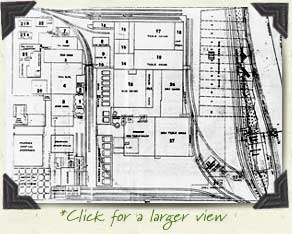
Douglas Starchworks 1918 Courtesy of Penford Products
1918 - The Douglas Starchworks was extensively expanded which added manufacturing capacity and a handsome new office building.
1919 - Disaster soon followed. The complex was wracked by a massive explosion at 6:30 in the evening of May 22nd, and the ensuing fire left a landscape resembling a war zone.
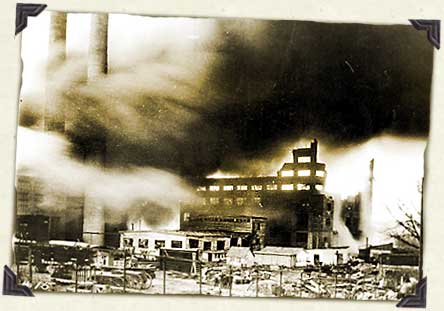
Starchworks disaster
Courtesy of Penford Products
The blast was so powerful that many downtown businesses across the Cedar River were damaged by flying debris.
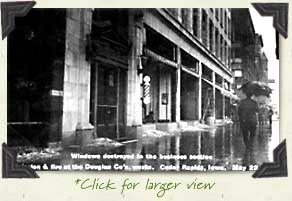
100 Block of 3rd Ave SE
The blast killed 43 people. It would have been much worse if the accident had happened during the day shift.
A quote from the USDA investigation report reads, "Ward Mathews, cone settling room attendant, stated that he was sitting in the window of the second story of the cone settling building looking across the 20-foot alley towards the dry starch packing room. He saw a flame come out of the second story window accompanied by considerable smoke. Then the force of the explosion pushed him eastward into one of the cone settlers where he was bridged over by a timber. He heard crashing sounds about him until he was rescued by the firemen. He was not burned but was badly bruised."
1919 - Following the disaster, stockholders deserted en masse but George Douglas was able to hold the company together until a Louisiana company, Penick & Ford Ltd. purchased it in December.
1921 - The plant was rebuilt and resumed production.
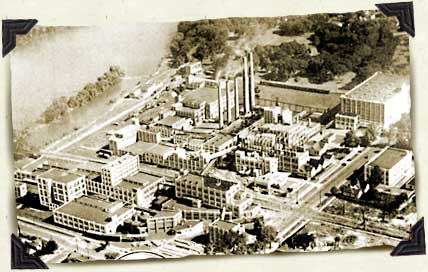
Photograph - Aerial view of Penick & Ford late 1920s
1923 - George B. Douglas died. His wife Irene Douglas, lived in the family home, Brucemore, until her death in 1937.
George Bruce Douglas had a profound influence on the industrial development of Cedar Rapids. His companies were early pioneers in moving corn products from field to table. Today multi-national companies such as Quaker Oats and Archer Daniels Midland process Iowa products and serve consumers worldwide through a multi-billion-dollar industry.
Sources:
Cedar Rapids, the Magnificent Century, Harold F. Ewoldt, 1988, Windsor Publications, Northridge, CA
Illustrated Historical Atlas of the State of Iowa, 1875, Andreas Atlas Co, Chicago
Progressive Men of Iowa, 1899, Conaway & Shaw, Des Moines
The Story of Cedar Rapids, Janette S. & Frederick G. Murray, 1950, Stratford House NY
History of Linn County Iowa Vol II, 1911, Luther A. Brewer and Barthinius L. Wick The Pioneer Publishing Company, Chicago
Views of Cedar Rapids, 1906, L.H. Nelson Company, Portland, Maine
Cedar Rapids, Iowa, U.S.A., 1891, Flower & Wilstach, Cedar Rapids, IA
Sanborn Fire Insurance Maps, 1895, updated through 1905
Glimpses of Cedar Rapids, Iowa, Wm. Baylis Photographer, Chas. B. Armstrong Publisher, 1898

Santa Barbara
California

March. 3, 1912
Dear Claire:
Your telegram giving February results was received yesterday. I am very much pleased over it. The figures are better than I expected. I am wiring you tonight saying that report is highly satisfactory. Also to advise Whipple that we will write him regarding the K.C. property next week. This means when I get back.
We will go over the matter then and make a new proposition.
I think you all in the office are deserving of congratulations because of the good February business. I know you have done your share to contribute to the favorable showing and I want to thank you for your careful and conscientious work. That is what counts for success.
I gave Chicago a check today for $1000.00 and send my Cedar Rapids National check herewith to offset same.

As previously advised I will be in Chicago on Friday at 11 A.M. or so. If anything develops so you may wish to communicate with me, write or wire to the Chicago Club. I will probably go home at 10 A.M. Saturday morning arriving that afternoon.

Yours truly
Geo. B. Douglas
(Written to Claire W. Bloomhall, Office Manager at Douglas & Company)
* This letter has been edited slightly to make it more readable for 21st century readers. The challenges of transcribing a handwritten letter include changes in spelling, punctuation and usage.

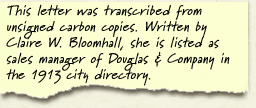
July 31st, 1913
Mr. Geo. B. Douglas,
"Goring Hall"
Worthing, Sussex, England
Dear Mr. Douglas,
I am writing you this short line so that you will be informed of the Starch market conditions.
During the past few days we have been having very rapid advances in Corn and cash No.3 grade Chicago is now around 64 1/2 to 65 cents.

The conditions in the corn belt are not at all satisfactory and if the hot weather continues as it has been for the past four of five days, a great deal of damage will be done. It was 102 in the office here yesterday and the Government thermometer registered 106 over town and the same the day before.
We had a slight shower this morning and thunderstorms are reported generally for the state of Iowa today and tomorrow so we are quite hopeful of a good soaking rain in the near future. It is greatly needed but even more so in some of the other states, such as Nebraska, Kansas and Oklahoma.
Some of the corn crop statisticians are estimating the crop at 2,750,000,000 which you will note is considerably less than last year. As soon as the Government report comes out on the 9th of August I will advise you fully of conditions, though perhaps you will get them in your daily paper.

We have been pounding away on Pearl and Powdered for the last 30 days and just about keeping even with our output up until yesterday when orders came pouring in rapidly. We booked a total of over 4,000 bags and barrels and 7 or 8,000 boxes.
There was an advance rumored of 25 cents on Lump and Package and 5 and 10 cents on Pearl and Powdered - the facts of which we have not yet obtained. However we wired the entire trade last evening to advance Pearl and Powdered ten points, making Chicago Pearl bases $1.97 without any change in Lump and Package goods.
We are oversold on this grade for 40 to 60 days and are fully taken care of on Pearl and Powdered for the month of August and under existing crop conditions prefer keeping close to shore. We are just about covered with corn purchases and manufactured stocks to cover our sales and with an erratic corn market must not take any chances.
We are not paying over 63 cents for but little of our corn but are bidding 64 1/2 cents today. We are successful in securing a sufficient supply to keep the plant in full operation, this month's showing should be quite satisfactory. The small stock of Pearl and Powdered which we have in the factory will come in very handy in taking care of our needs if we should be compelled to shut down for a few days for lack of corn.

It is not a question of price with the farmers as we are bidding right up to the top and sometimes over, but they will not let loose of the corn - most likely due to the unsatisfactory conditions of the growing crop.
We had a little shower yesterday but not sufficient to help very much and we are all hoping for a good soaking rain throughout the entire belt at an early date.
Everything is going along quite satisfactorily in the factory, having full force and no difficulty in securing plenty of labor. Matters in the office are almost most pleasant. Our only trouble is the extremely hot weather.
Andrew was in to see me a few days ago and reported everything going along very satisfactorily at your home.
I regret having delayed in forwarding you the enclosed statement but trust the same will arrive well in advance of your leaving for this country.
With nothing of further interest at the moment, I remain,
Respectfully yours,
E-K
* This letter has been edited slightly to make it more readable for 21st century readers. The challenges of transcribing a handwritten letter include changes in spelling, punctuation and usage.


As a team of curators, describe exactly what you see in this photograph. Your description should help someone who has not previously seen this image, to visualize it.
Place your team of curators into partner groups. Divide the questions below among your partner groups. When each group has formulated inferences about the photograph, convene your group and share your observations.
List the questions you will need to research in order to learn more about this photograph.
*Questions were adapted from a list written by Loren Horton, former hi

Copyright © 2022 CampSilos | All Rights Reserved
National Standards | Silos & Smokestacks | Credits | Awards
Crafted by IFC Studios, a midwest Branding Agency.